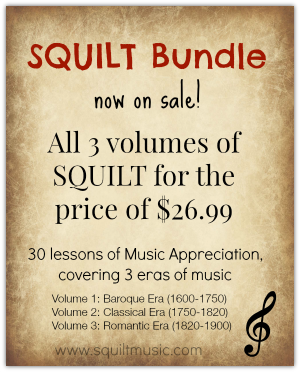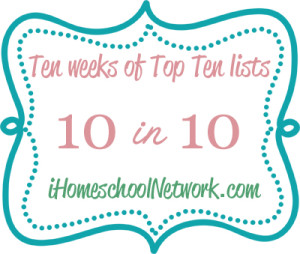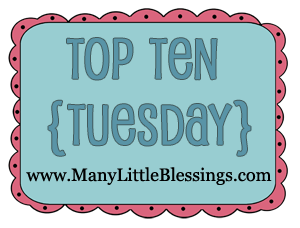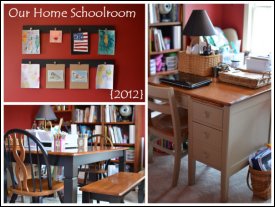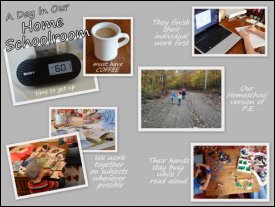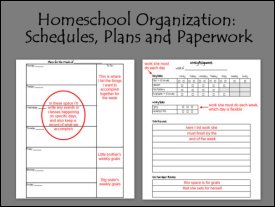 Hi, I'm Heidi and I homeschool my two sweet kids. I want them to know that learning is an exciting lifelong adventure! We love great books, unit studies, notebooking, lapbooking, and hands-on learning.
Hi, I'm Heidi and I homeschool my two sweet kids. I want them to know that learning is an exciting lifelong adventure! We love great books, unit studies, notebooking, lapbooking, and hands-on learning.Easy Music Appreciation…for the Non-Musical Mom
I’ve mentioned the SQUILT music appreciation curriculum several times when talking about our Tea Time resources. I think it’s high time I posted a full review!
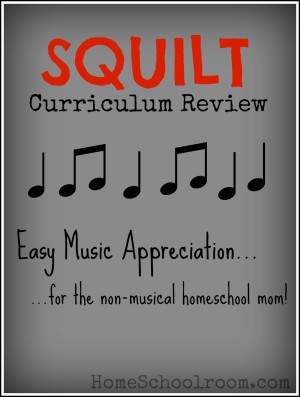
Note: I am an affiliate for this curriculum that was created by a fellow homeschool mom, and the links in this review to the SQUILT website are my affiliate links. Like all my reviews, these are my honest opinions after using the materials in our homeschool.
SQUILT is a music appreciation program created by Mary of Homegrown Learners. The name is an acronym for Super Quiet UnInterrupted Listening Time, a technique Mary used as a school music teacher and then as a homeschool mom. The basic premise is to listen intently and learn about one music selection at a time.
There is so much information in the SQUILT volumes, and you can use as little or as much as you like! Printable charts help you come to know important terms in music: rhythm and instrumentation, dynamics and tempo, and instruments.
I have no background in music education, having been a piano lesson dropout and avoiding any and all music classes thereafter. SQUILT is a terrific tool for a mom like me, who wants to learn about classical music alongside her children. I simply open the lesson and we enjoy it together.
What is involved in a SQUILT lesson?
Each lesson includes the name and composer, a brief background of the piece, at least one link to listen to the piece free online (no CDs to buy!), and often other links to related videos: performances of the piece, etc. You could spend as little as ten minutes on a lesson, listening to the selection of music first in complete silence (preferably with eyes closed), then listening again and filling out the included printable SQUILT record sheets.
During the first time listening I have my children face in opposite directions to minimize temptation for my ham of a son to make crazy faces to elicit big sister’s laughter!
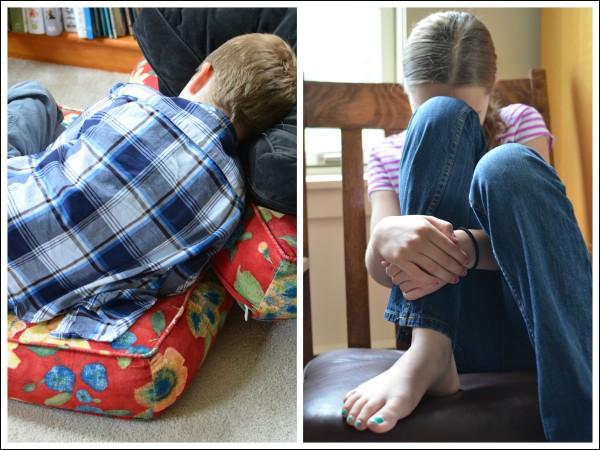
Mary includes two styles of notebook pages to record the lesson if you choose: one for older children with space to write about the details and one for younger children with space for drawing what they hear. This works perfectly in our home, with my pianist daughter filling out the written sheet and my eight-year-old son drawing his reaction on the other sheet. Mary’s notes on the dynamics, rhythm/tempo, instrumentation and mood help this musically-deficient mom have an intelligent conversation with my children about classical music!
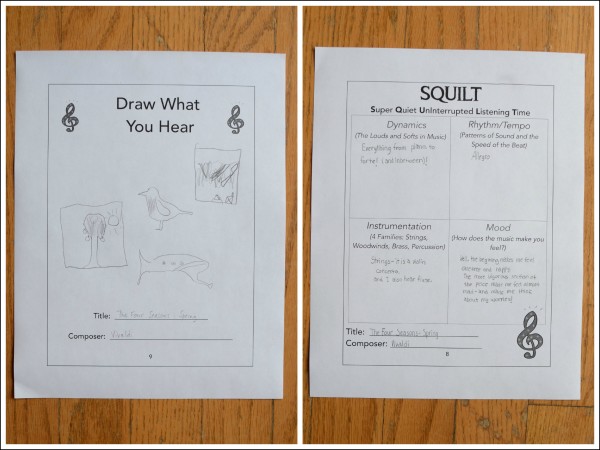
You can really stretch the lesson over a longer period of time, listening to the piece repeatedly and exploring the extra ideas (complete with printable notebooking pages) that Mary puts right at your fingertips. The lessons are filled with information about specific instruments, musical terms, and classical music itself along with links for further reading, listening, and viewing.
The “extras” vary depending on the lesson, but there’s always a treasure trove of ideas for further study and to build your knowledge of classical music. Here are some of the things we’ve enjoyed while using the SQUILT curriculum:
- We learned about “Pachelbel flattery” where more modern music uses parts of Pachelbel’s Canon (Volume 1, Lesson 1), and followed links to hear it in action. My daughter went on the play a variation of Canon in D (arranged by George Winston) for her piano recital.
- There are extra notebooking pages throughout: one for each composer (my daughter likes to research the composers), others on the time period, a certain instrument or style of music, or the background of the music. We used the printable of the poem that accompanies Vivaldi’s Spring as copywork (Volume 1, Lesson 4).
- Learning about Tchaicovsky’s “Love Theme” from the Romeo and Juliet Fantasy Overture (Volume 3, Lesson 9) led us to listen to the whole piece…then read an adaptation of the play…then watch the entire play on YouTube!
- We learned more about the pipe organ while studying Tocatta and Fugue in D Minor by Bach (Vol. 1, Lesson 7). It prompted us to take a closer look at the pipe organ in our church, and we learned so much about something that’s been right in front of us for years and have a greater appreciation for the amazing instrument it is.
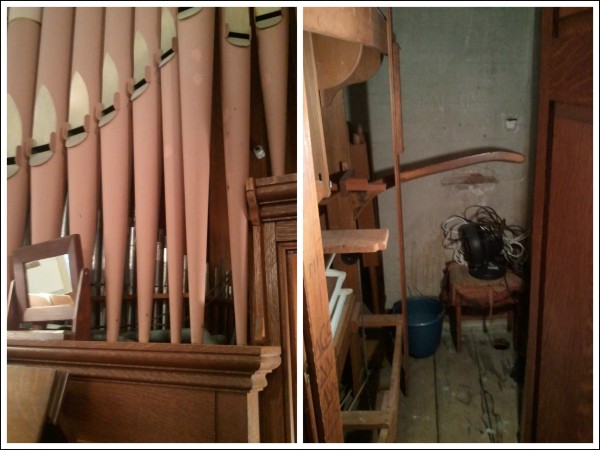
What do I think is so special about SQUILT?
Here’s what I think is truly unique and incredibly beneficial: you build appreciation one piece of music at a time!
As Charlotte Mason style homeschoolers, we strive to learn about famous composers and grow love for their music. I play classical music when it can be an enriching background, but using the SQUILT technique is like picture study (where you focus on one masterpiece until your child can recall it from memory). Listening to a piece of music and really focusing on it builds a relationship with it that merely having music in the background does not.
SQUILT is a helpful technique that you could use and apply to other pieces of music, but the information from Mary’s notes and ideas for extra learning are well worth the money to me! I honestly wouldn’t even know where to begin to choose music to study.
Add Music Appreciation to your Homeschool with SQUILT:
There is great information on the SQUILT curriculum website. You can download sample pages under the “Freebies” tag and see the table of contents for each volume under the “SQUILT Curriculum EBooks” tab.
Right now there are 3 volumes of SQUILT, with 10 lessons per volume. I enjoy how Mary has arranged the lessons by era, so those of us studying history chronologically can use the volume that coincides with our studies. You can buy volumes individually for under $10, or right now snag all three available volumes for $26.99!
How I Teach Homeschool Fine Arts
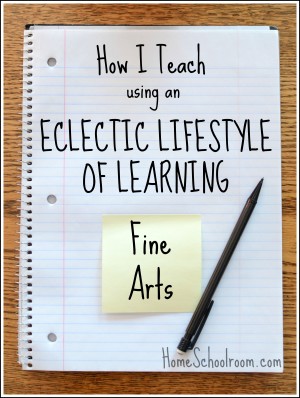
This is the final installment in the “How I Teach” series, where I’ve been sharing how I approach each subject area. It’s time for the finishing touches: fine arts.
What do I try to cover in fine arts?
This is where I bring in the beauty, all that is lovely in classical music and art, theater and dance. I’m interested in two things: appreciation of beauty through experience and education, and also opportunities to produce beauty.
Why are fine arts necessary?
Why bother with fine arts? Aren’t they just frosting? Well, one of my favorite homeschool authors says it better than I can:
Great paintings, like great music, are part of our common culture. They are part of the core that educated people enjoy and share and through which we all gain deeper understanding of human possibilities in this world…What we want is for the children to use their minds in a kind of thinking that they don’t experience while practicing subtraction or learning the past tense of verbs…Study more than the tyrants and wars of the past. Enjoy the best of civilization. Enjoy music and art.” Ruth Beechick in You Can Teach Your Child Successfully
How Do I Teach Homeschool Fine Arts?
I was initially nervous trying to cover fine arts because of my limited knowledge, but I’ve found great joy in learning alongside my children using simple techniques and a myriad of available resources.
*This post contains affiliate links to products I use and enjoy in our home.
- Both my children take private music lessons that include music theory. This one requires the highest financial sacrifice and time commitment, but also has the largest life-long benefit. My children both have developed a love for their instrument and enjoy playing for others, both informally in our home and at recitals and church.
- My eleven-year-old daughter recently joined the adult choir at our church, which is not only providing a lot of music educations, but a lasting relationship with the choir director, the delightful members of the choir, and the lovely songs they sing.
- This is our second year utilizing Harmony Fine Arts, an art and music appreciation curriculum created by Barb, a homeschool mom who just graduated her third child. Her materials have been instrumental in our fine arts education: she provides a fabulous framework to help me know what to introduce, leads me to wonderful resources (like The Story of the Orchestra), and provides instruction in methods that are simple and enriching, like picture study. And here’s a great tip I learned from her: discounted calendars are an inexpensive way to obtain large full-color prints by famous artists. I just picked up a Monet calendar for $3 at an art museum!
- Another homeschool-mom-created curriculum that I love using is SQUILT by Mary from Homegrown Learners. The Super Quiet Uninterrupted Listening Technique helps your children form a personal relationship with great classical music, and Mary provides the background information to allow you to have educated discussions with your children about what they hear.
- Two other easy to use resources are Maestro Classics CDs (I bought Peter and the Wolf for Christmas), and listening to Classics for Kids, an excellent radio show (you can listen online or as a podcast) that teaches children about composers and pieces of music.
- We go to experience fine arts when possible. We’ve enjoyed wonderful opportunities: Shakespeare’s Twelfth Night, a production of The Nutcracker with full orchestra, the musical Annie, an on-stage radio theater presentation of A Christmas Carol, art museums, etc. This can also become expensive so I watch for discounted tickets. I also use quality DVD recordings, like we did for CATS, to bring the productions to us.
- To produce art I use resources like Storybook Art, keep supplies on hand and allow my children free use of them, and use ideas from my Art and Artist Study Pinterest board for learning about great artists and producing our own art. We also enjoy participating in Sketch Tuesday at Harmony Fine Arts. Email your sketches on that week’s theme, and then enjoy a slideshow of everyone’s drawings.
- We’ve begun studying hymns using the book Then Sings my Soul: 150 of the World’s Greatest Hymn Stories. It’s simple: I read the story of the hymn from the book and find a YouTube video with the words displayed on the screen. We listen regularly and try to sing along until we’ve learned it.
I hope this in-depth look into how I teach each of the subjects has been helpful. I love learning alongside my children and finding the methods that work for all of us to enjoy the journey of education.
The “How I Teach” Series:
- Our Family and Philosophy
- How I Teach Language Arts
- How I Teach Math
- How I Teach Science
- How I Teach History
- How I Teach Fine Arts
Scheduling Tea Time for the Extras and 10 Tea Time Snacks
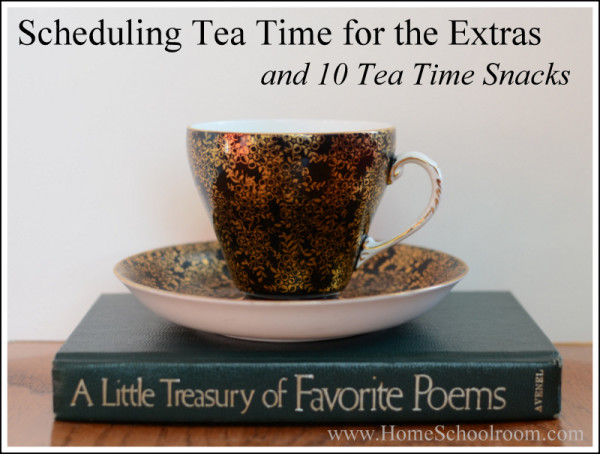
As I’ve been taking the time to reflect on our last school year and iron out what my goals and plans are for next year one thing I’m really excited to institute is a tea time. I’m planning to use it as a time to focus on those lovely “extras” that are a hallmark of the Charlotte Mason style education. We’ll sit down together over a cup of tea and a treat and share poetry and fine art and music.
Anytime I read about other homeschool moms setting aside tea time I liked the idea of making it a special time in our day. Then when I read about Elevenses from Ellen at the Bluestocking Belle I realized the 11:00 time slot would be a good fit for us, too. It will work better than an afternoon tea-time, because often by afternoon we’re either heading to an activity or errands or I’m settling them in for Quiet Time (a daily habit I can’t do without). It also will be a good time to transition between their individual work that starts our day and the subjects we study together.
Step #1 to make this a special time to look forward to in our schedule is having a sweet edible treat. I’m conscious of it being a treat, but not too unhealthy. And although I enjoy baking some days are too busy and I don’t like to have large amounts of sweet baked goods in the pantry (because then I’m tempted to eat them all day long). My answer to those problems are baking things I can freeze. That way we’ll only keep out a little for our tea time and it will also give us variety because every few days we can pull something different from the freezer.
From A to Z here are my go-to freezer-friendly sweet treats I plan to keep stocked for our tea time.
#1 Apple Bread
I use the Apple Walnut Bread recipe from Allrecipes.com, minus the walnuts because my kids don’t like them. I just love the rustic nature of this sweet bread with chunks of apple. I cut the calories a bit by decreasing the oil to 1/2 cup and increasing the applesauce to 1/2 cup. The recipe yields two loaves.
#2 Banana Bread
This recipe comes from an old Canadian cookbook treasured by my mother. I made a few substitutions to make it a bit healthier and everyone still asks for the recipe. This recipe also yields two loaves.
- 2 cups mashed overripe bananas (5-6 bananas)
- 1 1/2 cups brown sugar
- 4 eggs
- 1/2 cup melted butter
- 1/4 cup applesauce
- 1 cup wheat flour
- 2 cups white flour
- 1/2 teaspoon salt
- 2 teaspoons baking soda
- 1 teaspoon vanilla
Mix bananas, sugar and eggs. Add butter, applesauce and vanilla; mix well. Sift together flour, salt and soda. Add to wet ingredients and mix well but don’t over-mix. Bake at 350 degrees for 45 minutes or until a toothpick inserted near the center comes out clean.
#3 Blueberry Muffins
These Blueberry Cream Muffins from Allrecipes.com are a family favorite. I use half brown sugar and half white sugar, and also increase the blueberries to 3 cups (you can add frozen berries right to the batter). It makes 24 muffins so I freeze as many as I can. After thawing I microwave them to make sure they are warm through, then pop them into the toaster oven for a minute–after that you’d swear they were fresh baked.
#4 Cinnamon Raisin Bread
This delicious homemade recipe for Cinnamon Raisin Bread from Allrecipes is a bit more work than most of these treats, but quite delicious. I cut the ingredients in half (because otherwise I think it would overload my Kitchenaid mixer) and it still makes two loaves. It does bake in less than the 45 minutes the recipe calls for, so be sure to check your bread early.
#5 Cranberry Bread
Have you every read Cranberry Thanksgiving? It’s a cute story, and on the back is the recipe for Grandma’s Famous Cranberry Bread. I’d tried several recipes before this that were not what I was looking for–this one is just right–just enough tart cranberry and orange flavor.
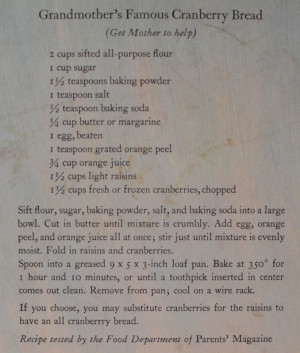
#6 Pumpkin Bread
This recipe for Downeast Maine Pumpkin Bread is terrific. And I’m not saying that just because I’m from Maine–I’m backed up by the 5,000 people who have reviewed it! It makes three loaves, so there is plenty to freeze.
#7 Rhubarb Bread
Every old garden in Maine has rhubarb growing in it. This recipe that was once listed in a local newspaper makes a delicious sweet bread from the tangy stalks.
- 1 1/2 cups packed brown sugar
- 2/3 cup vegetable oil
- 1 egg
- 1 cup buttermilk
- 1 tsp. salt
- 1 teaspoon baking soda
- 1 teaspoon vanilla
- 2 1/2 cups flour
- 2 cups diced rhubarb
Mix brown sugar and oil until smooth. Add egg, buttermilk, salt, soda, vanilla and flour. Blend until moist. Fold in rhubarb. Pour into two greased loaf pans and bake at 350 degrees for 50-55 minutes or until a toothpick inserted near the center comes out clean. (By the way, if you don’t have buttermilk just put one tablespoon of vinegar into a measuring cup, add milk to make 1 cup total liquid and let stand for 5 minutes before using.)
#8 Scotch Tea Muffins
These are plain muffins that are perfect for pairing with homemade jam. The recipe came from an old Canadian cookbook my mother treasures.
- 2 tablespoons butter
- 1 egg
- 4 cups flour
- dash salt
- 1 1/4 cups sugar
- 1 1/4 cups milk
- 4 teaspoons baking powder.
Mix dry ingredients. Then add wet ingredients. Bake at 350 degrees fro 15-20 minutes.
#9 Whole Wheat Bread
I love this Simple Whole Wheat Bread recipe from Allrecipes.com. It makes three loaves so the work involved really pays off and I’ve had wonderful luck with it. When I first started making it I tried freezing the dough before it rose at all, freezing after the first rise and freezing after it was baked. The already baked bread tasted wonderful from the freezer and the bonus: that was the easiest, too, because it can be taken right out of the freezer, thawed and enjoyed just like fresh baked. If anyone has frozen store-bought bread before you may notice the texture suffers after you thaw it. This is not the case with homemade bread–trust me!
#10 Zucchini Bread
And last, but certainly not least, a recipe for Zucchini Bread from Allrecipes.com. If your children balk at the idea just feed it to them first before you tell them what’s in it. My children love this bread.
What Will We Do During Tea Time?
- We’ll read poetry aloud with a goal of memorizing one poem each month.
- Homeschool Share has regular Tea Time posts with information and links for studying poets, composers, and artists.
- These next two resources have helped expose and educate me along with my children in subject areas that were challenging for me. I had almost no experience or knowledge in fine art and music and these resources from fellow homeschool moms are invaluable.
- Fine art and music appreciation is planned for you with Harmony Fine Arts. We’ll be using Grade 5 this year to go along with our history studies.
- Mary from Homegrown Learners shares her classic music appreciation technique of Super Quiet UnInterrupted Listening Time. I’m an affiliate for her just-released ebook with 10 SQUILT lessons because I honestly love this resource. The information she shares on each piece of music is crucial for me to share intelligently with my children. Click here to visit Homegrown Learners.
Hop over to iHomeschool network for more top ten lists.
This blog hop series was inspired by Angie of Many Little Blessings where you’re welcome to link up, too!
A Week Filled With Good Things
This week was filled with easing back into our full time schedule and extracurricular activities after the flu. We made time for afternoon rest and early bedtimes, and continued lots of cozy reading aloud. In fact, this week felt very in tune with Charlotte Mason’s philosophies. I am by no means an expert, but our homeschool does feel full of good things when I implement her methods. We enjoyed good books, poetry, nature study, and composer study.
What books are we enjoying right now?
- We flew through Little Town on the Prairie and feel the impending sadness of the time when Laura’s story won’t be part of our days. My daughter has asked if we can just start again at the beginning.
- American History Stories from Heritage History. (That’s a selection from the Early America CD, which you can receive for free if you purchase any other CD and use the discount code SCHOOLRM until January 31st.) This series is giving my kids (and me!) a good overview of the time period we’re studying while allowing us to spend more time on major events.
- The Burgess Bird Book for Children is part of our nature study focus on birds. The stories are fact-filled and the personalities of each bird we meet keep it engaging.
- We just started The Cricket in Times Square for our homeschool book club…it’s also very engaging so far and leads to cries of “You can’t stop there!”
- I shared poems from A Small Child’s Book of Cozy Poems all week.
Nature study goes to the birds
Our nature study is deepening as we become more and more intrigued by birds. There are three reasons for our increased interest: we’re gearing up for the Great Backyard Bird Count in February, we’ve seen new birds at our feeders, and we’ve been watching nest cams! On these down days requiring a little extra rest we’ve watched this hummingbird nest cam in California and this eagle cam in Florida and been fascinated by the lives of these two (very different) bird families.
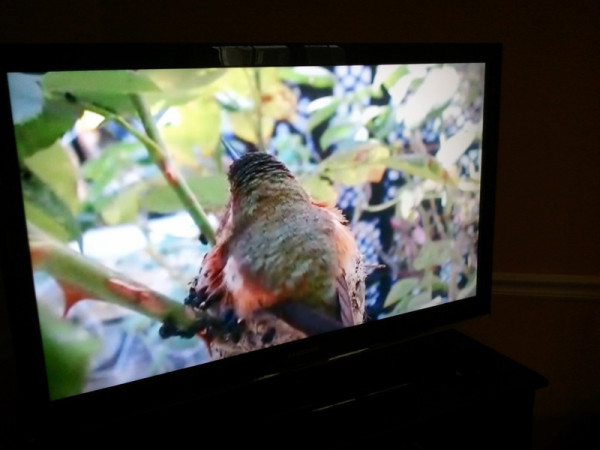
Obviously in nature study the goal is to be out in nature in direct contact with the items you are studying, but these live streaming videos enable us to watch events that would be impossible otherwise. We’ve watched the baby hummingbirds politely excrete wastes over the edge of the nest, how often the momma has to feed those babies and how she does it. We exclaimed as we watched Daddy eagle drop off a fish for his eaglets and their mom. The interest spurred by watching these bird families led to checking out more books at the library!
I had my children pick their favorite from our backyard birds and create a notebook page this week. I love setting them free to notebook as they choose and watching them make the work their own. You can download a free coloring book from Cornell with great line drawings. I like the images but not the questions, so they colored the image, cut it out, and pasted it onto their notebook page of choice. Then they added the details that interested them.
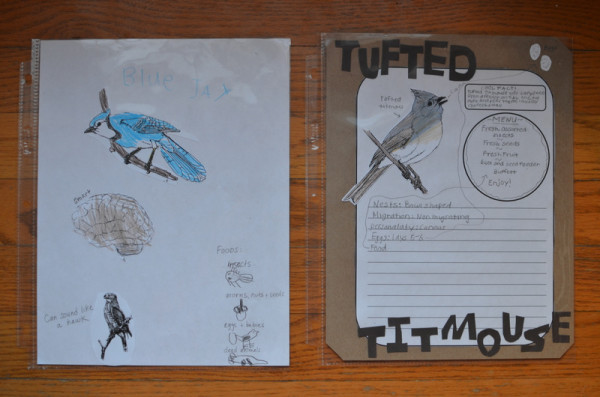
Composer study and our first try at SQUILT
In Harmony Fine Arts our composer of the month is Mozart. We listen to his music during quiet time each day. I’ve been wanting to try the SQUILT technique from Mary at Homegrown Learners and have them really focus on a piece of music. (This post explains the basics of Super Quiet UnInterrupted Listening Time.) She posted a new SQUILT lesson on Mozart yesterday so it was the perfect time to try it.
SQUILT was a great addition to our fine arts studies using HFA! I plan for SQUILT to become a regular part of our week using one of the songs from our composer of the month. Mary’s downloadable SQUILT form was a perfect fit for my ten year old piano-lesson-loving daughter, but I gave my son a sheet of plain paper to draw on.
Mary’s advice on younger or more wiggly children–to allow them to move around during the music and draw on plain paper–was helpful for my seven year old son. If I said “You must sit still and not move and then write words on this paper in these squares” I would turn his happy, open attitude about our classical music studies into dread.
I did learn one thing with our first go-round: my silly son wanted to make faces (albeit to the tempo) to entertain his sister, so we’ll be facing opposite directions or have our eyes closed next time!
And just for fun…
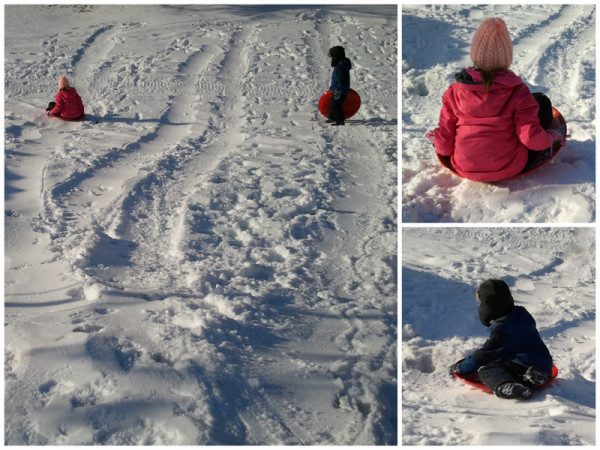
The week ended with a little fun in the snow. I dare an adult to watch a kid flying down a hill on a saucer sled and not join in. I had to jump on a sled and try it out…I laughed the whole way down but I think I’ll have bruises to show for it!
In case you missed it:
I shared a spur-of-the-moment simple hands-on math activity with odd and even numbers. The concept and vocabulary clicked for my seven year old. (You know, that same little boy that made faces during our classical music selection?) He loves (and needs) hands-on learning and asked to play the same odd-even game several times this week.
Thank you to the wonderful hostesses with fun link-ups on Fridays. Be sure to join the fun and see what other homeschoolers are up to!
